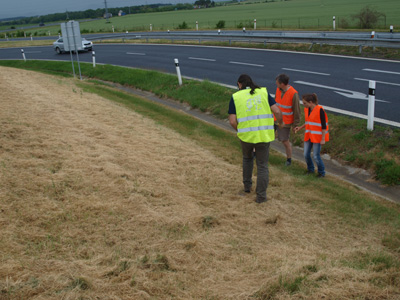Requirements for road maintenance
(Working Group No. 4 - coordinator MSc. Tomas Sikula)
When designing, setting up and subsequently maintaining vegetation along roads industry standards must be respected: especially CSN 73 6101 Design of highways and motorways,
CSN 83 9021 Vegetation technology in landscaping - Plants and plant care, CSN 83 9031 Vegetation technology in landscaping - Turf and seeding, CSN 83 9051 Vegetation
technology in landscaping - Care of vegetation during development and maintenance in green areas, as well as departmental regulations, technical conditions
(hereinafter abbreviated TP) 99 Seeding and maintenance of road vegetation, Appendix 1, TP 53 Anti-erosion measurements on transport structures slopes, Specifications
for road constructions (TKP), chapter 13 landscaping.
Preparation and methods of slope vegetation along roads are specified by several technical standards, so the result of slope revitalization is closed stand without
bald patches. Implementation procedures can be summarized in these few key points:
- Before the establishment of turf, it is necessary to spread the soil on the road slopes. The soil is spread in a layer at least 10 cm (optimally 20cm) high; the base must allow the movement of water, air and nutrients binding. For this purpose the subsoil (underlying soil horizons) is used, and just in exceptional cases soil (humus horizon).
- Standard seeding can be performed on slopes up to a maximum inclination of 1:1.5 (i.e. 33 ° resp. 67%). On steeper slopes it is necessary to use other erosion control measures (geotextiles, Geomats, grass mats).
- A final seed mixture must meet the following requirements: rapid germination and initial growth; endurance on site; low growth not requiring frequent mowing; tolerance to stress conditions (e.g. increased soil salinity through spatter from the road surface during winter); modesty in nutrients and intensity of care; anti-erosion effect; good tillering; good competitive ability.
- Technical conditions (TP 99) show exemplary grass mixtures for different types of sites (by soil and climatic characteristics, slope/site exposure - e.g. mixture for the dividing strip). The basics of these mixtures are: Festuca, Poa pratensis, Lolium perenne, with an admixture of 5-15% of other species such as Agrostis capillaris, Deschampsia caespitosa and Phleum bertolonii.
In selection of vegetation, the emphasis is on low-productive grass mixtures requiring only occasional mowing in theory; yet high-productive grasses are commonly seeded.
Vegetation seed mixtures are often based on the most inexpensive mixtures of forage grasses. These cultivars of grasses are unfortunately characterized by their high
biomass production and for that purpose are therefore unsuitable. The result of using forage grass mixtures is a high vegetation maintenance cost through mulching
or mowing, twice or three times a year.






